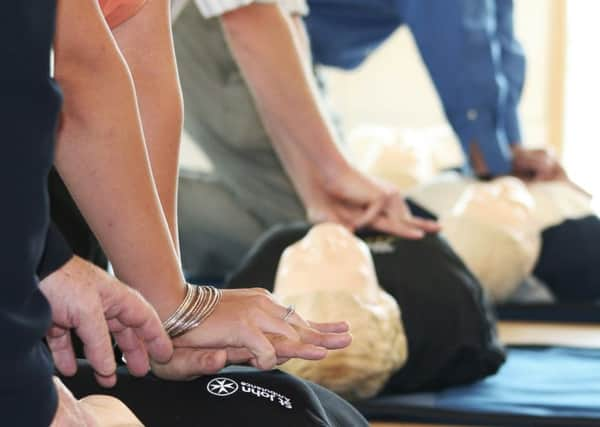ST JOHN AMBULANCE: How to correctly perform CPR on an adult
This article contains affiliate links. We may earn a small commission on items purchased through this article, but that does not affect our editorial judgement.


On discovering a collapsed casualty, check the scene for danger and establish whether he is conscious or unconscious, tap his shoulders and ask loudly and clearly ‘What has happened?’ or give a command such as ‘Open your eyes’.
To check whether the casualty is breathing, look, listen and feel for normal breathing.
Advertisement
Hide AdAdvertisement
Hide AdLook for chest movement, listen for sounds of breathing and feel for breath on your cheek.
Do this for no more than ten seconds and if the casualty is not breathing, begin CPR.
Kneeling at the side of the casualty, place the heel of one hand on the centre of the chest.
Do not press on the casualty’s ribs, stomach or bottom of breastbone.
Advertisement
Hide AdAdvertisement
Hide AdPlace the heel of your other hand on top and interlock your fingers but keep them off the casualty’s ribs
Leaning over the casualty press straight down to 5 or 6cm keeping the elbows straight.
Release the pressure but do not take your hands off the chest. Give 30 compressions at a rate of between 100-120 per minute.
Move to the casualty’s head.
Support his chin with the fingertips of one hand and with the other hand, pinch the soft part of his nose.
Advertisement
Hide AdAdvertisement
Hide AdTake a breath and place your mouth over the casualty’s mouth making a good seal – use a pocket mask if possible.
Breathe steadily into the casualty’s mouth for one second. Watch the chest rise.
Keeping your hands in position, remove your mouth and let the chest fall. Give two rescue breaths.
Continue giving 30 chest compressions and two rescue breaths until one of these things happens: professional help takes over; the casualty starts to wake up, open his eyes and breathes normally; you become exhausted.
Advertisement
Hide AdAdvertisement
Hide AdIf you are unable, unwilling or untrained to give rescue breaths, you can give chest compressions only.
• For those looking for quick, easily accessible first aid information, the St John Ambulance app is available free on smartphones and the website (www.sja.org.uk) offers demo videos, an interactive game, and lots of free advice. For more information about first aid courses please call 0303 003 0101.
Don’t miss out on all the latest breaking news where you live.
Here are four ways you can be sure you’ll be amongst the first to know what’s going on.
Advertisement
Hide AdAdvertisement
Hide Ad1) Make our website your homepage at www.littlehamptongazette.co.uk/
2) Like our Facebook page at www.facebook.com/LittlehamptonGazette
3) Follow us on Twitter @LhamptonGazette
4) Register with us by clicking on ‘sign in’ (top right corner). You can then receive our daily newsletter AND add your point of view to stories that you read here.
And do share with your family and friends - so they don’t miss out!
The Littlehampton Gazette - always the first with your local news.
Be part of it.